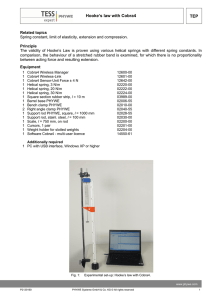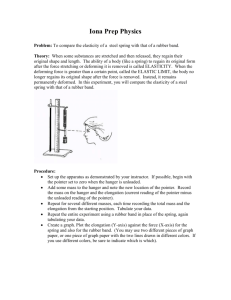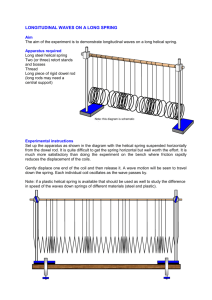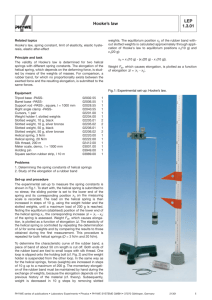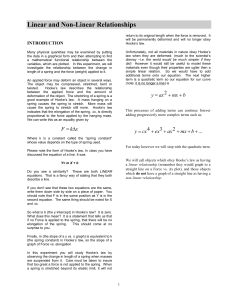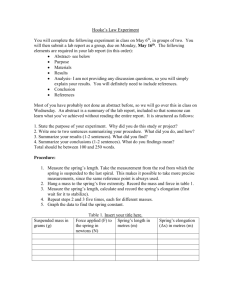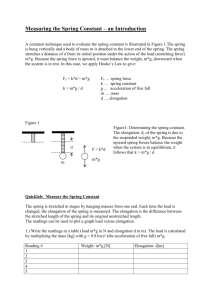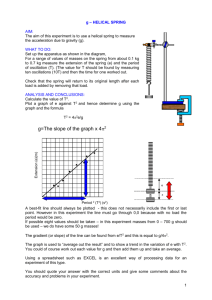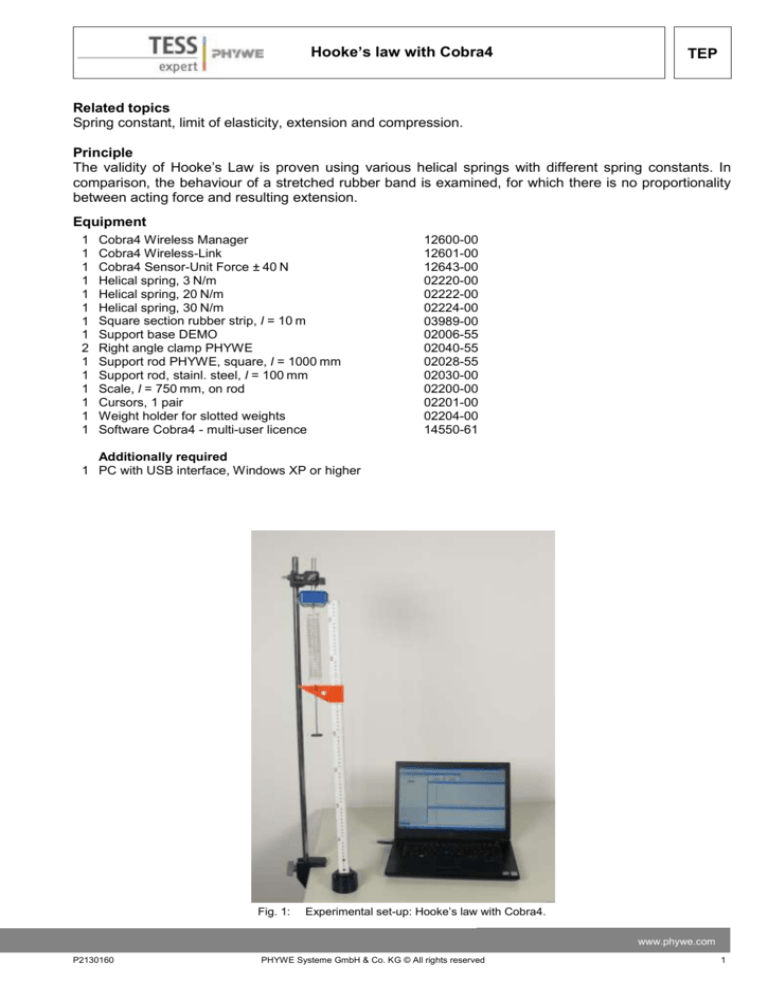
Hooke’s law with Cobra4
TEP
Related topics
Spring constant, limit of elasticity, extension and compression.
Principle
The validity of Hooke’s Law is proven using various helical springs with different spring constants. In
comparison, the behaviour of a stretched rubber band is examined, for which there is no proportionality
between acting force and resulting extension.
Equipment
1
1
1
1
1
1
1
1
2
1
1
1
1
1
1
Cobra4 Wireless Manager
Cobra4 Wireless-Link
Cobra4 Sensor-Unit Force ± 40 N
Helical spring, 3 N/m
Helical spring, 20 N/m
Helical spring, 30 N/m
Square section rubber strip, l = 10 m
Support base DEMO
Right angle clamp PHYWE
Support rod PHYWE, square, l = 1000 mm
Support rod, stainl. steel, l = 100 mm
Scale, l = 750 mm, on rod
Cursors, 1 pair
Weight holder for slotted weights
Software Cobra4 - multi-user licence
12600-00
12601-00
12643-00
02220-00
02222-00
02224-00
03989-00
02006-55
02040-55
02028-55
02030-00
02200-00
02201-00
02204-00
14550-61
Additionally required
1 PC with USB interface, Windows XP or higher
Fig. 1:
Experimental set-up: Hooke’s law with Cobra4.
www.phywe.com
P2130160
PHYWE Systeme GmbH & Co. KG © All rights reserved
1
TEP
Hooke’s law with Cobra4
Tasks
Calibration of the system (movement sensor and force sensor). Measurement of the tensile force as a
function of the path for three different helical springs and a rubber band. Determination of the spring
constant and evaluation of a hysteresis curve.
Verification of Hooke’s law.
Set-up and procedure
The experimental set-up to measure the spring constants is shown in Fig. 1.
Hang one end of a helical spring on the clamp of the Sensor-Unit. Connect the weight holder with the
other end of the spring and place it on the cursor.
Connect the Cobra4 Wireless Manager to the USB interface of the computer, plug the Cobra4 SensorUnit Force ± 40 N on the Cobra4 Wireless-Link and fix the combination to the stand.
Load the “Hooke’s law” experiment. (Experiment > Open experiment). All pre-settings that are necessary
for measured value recording are now carried out. Click on
in the icon strip to start measurement.
Press space bar or click on
to get the value for l = 0 mm. Now pull the
spring with help of the weight holder down and take a value every
10 mm. Finish the experiment at l = 200 mm and click on the
icon in
the icon strip to end measurement.
Hold the spring in this position and transfer all measured data to “measure”.
Fig. 2: Saving measurements
Save the measured data by clicking on the menu prompts “File” and
“Save measurement” (Fig 2).
Now change the function of the calculated channel (right click on “Virtual devices””Setup”; mark the
corresponding channel and click on “edit”) to “210-(Number*10)”. Save these settings, start a new measurement and relax the spring step by step. Repeat this procedure for the different helical springs and the
rubber band.
Theory and evaluation
When forces act on a solid body, the resulting
deformation (translation and rotation movements
are suppressed in the following) depends to a
large extent on the material as well as on the size
and on the direction along which the exterior
forces act. When the solid body regains its original shape after the exterior force stops acting,
that is, the interior restoring forces of the material
can bring the solid body back to its original equilibrium position, the material is called elastic. A
helical spring is a very simple example of an
elastic body (see Fig.3). In addition, if deviations
Δl from the equilibrium position l0 of the helical
spring are not very large, the restoring force FR of
the spring is found to be proportional to its elongation (or to its compression) Δl (Eq. 1):
Fig.3: Measurement of the elongation of the helical
spring
⃗⃗⃗⃗
𝐹𝑅 = −𝐷∆𝑙
2
PHYWE Systeme GmbH & Co. KG © All rights reserved
(1)
P2130160
Hooke’s law with Cobra4
TEP
This is Hooke’s law or the linear law of forces, where the proportionality constant D, which is a general
magnitude of reference, is called the spring constant in the case of a helical spring. If an exterior force
acts on the spring, such as a weight FW = m ・ g of a mass m (g = 9.81 m/s2: acceleration of terrestrial
gravity), a new stable equilibrium is reached for the length of the spring l1, for which the weight mass m
is equal to the restoring force of the spring (Eq. 2):
𝐹𝑅 = 𝐷∆𝑙 = 𝑚𝑔 = 𝐹𝑊
(2)
The elongation of the helical spring is therefore proportional to the forces FW (exerted by the weights in
this example) (Eq. 3):
∆𝑙 =
1
𝐹
𝐷 𝑊
(3)
as is also shown by the characteristic curves of the two helical springs (Figs. 4 and 5).
Fig.. 4:
Fig.. 5:
Characteristic elongation curve for a helical spring with D = 20N/m.
Characteristic elongation curve for a helical spring with D = 3 N/m.
www.phywe.com
P2130160
PHYWE Systeme GmbH & Co. KG © All rights reserved
3
TEP
Hooke’s law with Cobra4
The SLOPE of the characteristic curves is the respective spring constant D of the helical springs.
Measurement values from Fig. 3 yield a spring constant of:
D = 21 N/m,
measurement values from Fig.4 yield a spring constant of:
D = 3 N/m.
Thus, forces required to cause a given elongation of the spring increase proportionally with the spring
constant. Using equation (4), the new equilibrium length l1 is found to be:
𝑙1 = 𝑙0 +
𝑚𝑔
𝐷
(4)
Proportionality between the restoring forces, as long as they are small, and the elongation of the solid
body are ascertained not only for the helical spring, but also for all other materials which are in a state of
stable equilibrium: the potential energy of forces between molecules is approximately parabolic
around a stable point of equilibrium. Restoring forces obtained by differentiating the potential are thus
proportional to the deviation from the rest position. Taking for example a rod or wire of a given material
of length l and cross-section A, to which a traction force F is applied, Hooke's law is expressed through
equation (5) and (6):
∆𝑙
𝐹
=𝛼∙
𝑙
𝐴
(5)
𝜀 =𝛼∙𝜎
(6)
or
where ε = Δl/l is the relative elongation of the rod, the proportionality factor α is the coefficient of elasticity
of the rod material and σ = F/A is the tension of the rod. Proportionality only holds up to a characteristic
limit stress. A schematic stress-elongation diagram for
a metal wire is shown in Fig. 6. The limit of proportionality (σP) generally lies below the elastic limit (σE),
above which the form of the solid body changes permanently, due to interior molecular re-arrangements.
In this range of stresses, the material is said to be
plastic. If the deforming forces exceed the limit of solidity (σB), the solid material begins to flow and the
body breaks (plastic deformation).
An example of a material which does not follow
Hooke's law, even when submitted to small forces, is
a rubber band. Fig. 7 shows the characteristic curve
of a rubber band, with continuously increasing stress
between the origin and the maximum elongation and
with gradual relief backwards. On the one hand, the
relation between acting weight FW and resulting elongation Δl is no longer linear: elongation is larger than
expected according to Hooke's law, considering the
measurement values for small stresses. On the other
hand, the degree of elongation depends on the previous history of the rubber band. In the characteristic
curve of the rubber band, the increasing part does not Fig. 6: Stress-elongation diagram (schematic).
coincide with the decreasing part, which is contrary to
4
PHYWE Systeme GmbH & Co. KG © All rights reserved
P2130160
Hooke’s law with Cobra4
TEP
what is observed for the helical spring, as long as it remains within the limit of elasticity.
This phenomenon is called elastic hysteresis. If the same rubber band is stressed again, elongation Δl
will now be significantly larger than had been the case for the new rubber band.
The hysteresis of the characteristic curve has two causes: on one hand, only part of the deformation reverts back to the original form momentarily, whereas the rest of the deformation reverts back over a period of several hours. This reversible process is called elastic after-effect, the material reacts viscoelastically.
On the other hand, once the elastic limit is exceeded, interior re-arrangements take place within the
material, which results in permanent changes of shape. This process is irreversible, because work is
converted to heat. In
this experiment, the effect of the elastic after-effect dominates.
Fig. 7:
Characteristic elongation curve for a rubber band.
www.phywe.com
P2130160
PHYWE Systeme GmbH & Co. KG © All rights reserved
5

